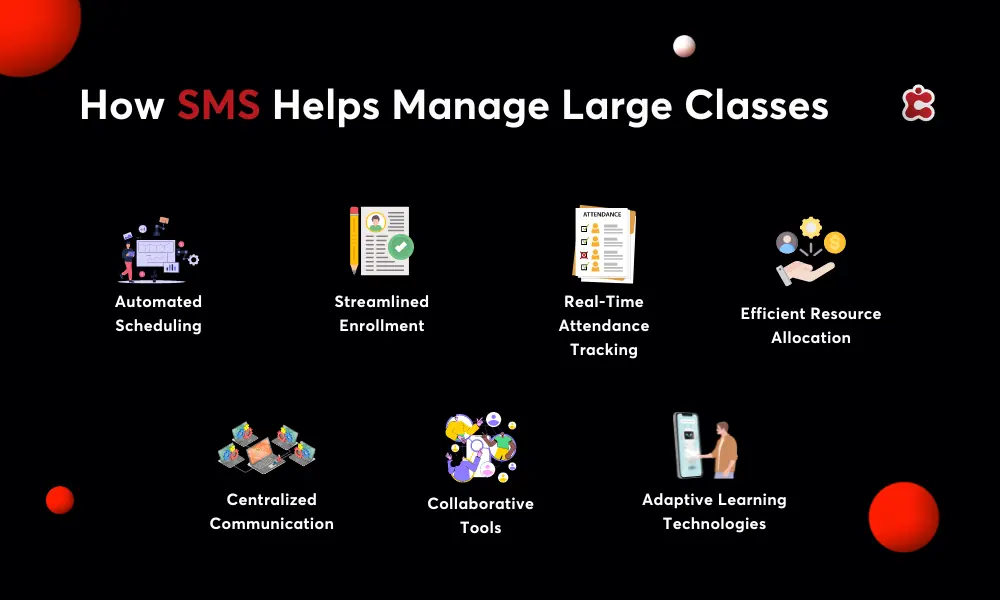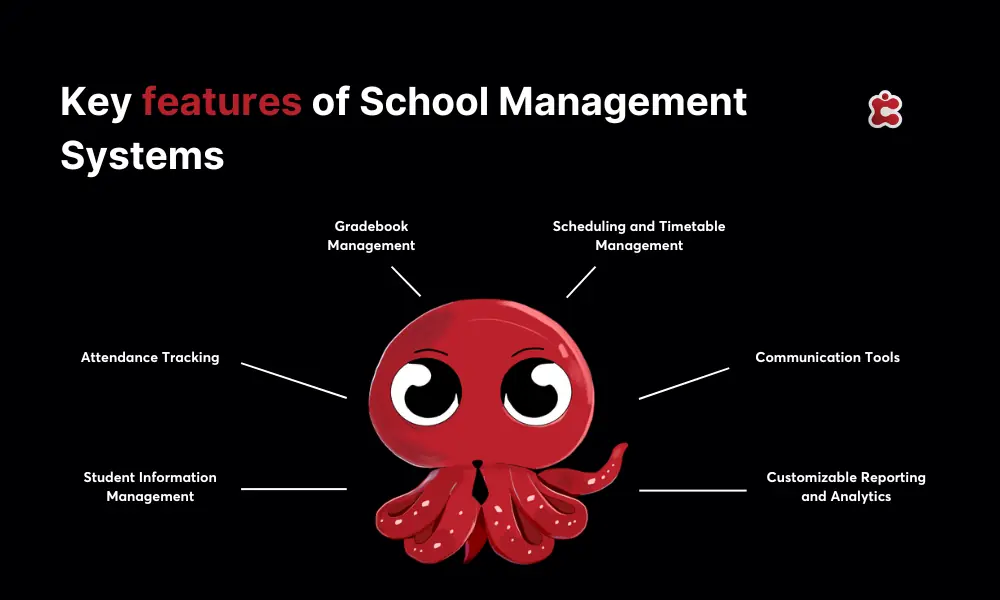Managing a large class can be a stressful experience. How do you keep students engaged? How do you know if they’re actually learning? Should you try to take attendance and risk losing precious time? How do you build rapport with over 100 students? These are dilemmas faced by colleges as class sizes continue to grow.
Effective class management is essential for student achievement and the smooth running of an institution. Students who feel lost in a sea of faces may lose interest and struggle academically.
However, your School Management System (SMS) can be a tool for addressing these issues. Consider the SMS your weapon for tackling these challenges head-on. An SMS can make an impact by automating tasks, enhancing communication, and offering tools to engage students.
We have compiled a manual to help you leverage your SMS to navigate the complexities of managing classes. We’ll explore everything from streamlining duties to enhancing student involvement and support.
Let’s get started!

Administrative Efficiency
Managing admin tasks can be quite a pain. From keeping track of attendance to organizing schedules and handling enrollments, there’s always a lot on the plate. However, what if there was a way to automate most of these tasks and save both time and effort? This is where a School Management System can truly excel.
Imagine the convenience of not having to arrange class schedules or assign rooms. An SMS can take care of this process automatically, ensuring that class schedules are optimized and rooms are utilized efficiently. Any rostering conflicts are minimized. This does not save time. It also reduces errors, making sure that students and staff are well-informed about their locations and timings.
Dealing with enrollments in classes can be overwhelming. With an SMS in place, you can automate the enrollment process. This includes managing waitlists and checking prerequisites automatically to ensure that students are placed in classes without intervention. This streamlined approach lightens the load and expedites the enrollment process making it smoother for students to access the classes they require.
Managing resources such as classrooms, teaching assistants, and equipment poses challenges. An SMS comes to the rescue by providing real-time data and analytics so that administrators can allocate resources effectively where they are most needed.
For instance, if a class experiences a surge in enrollment, the system could recommend moving to a different classroom or assigning extra teaching assistants to handle the larger group.
Communication and Collaboration
Communication among 100-plus students can seem like an overwhelming task. How do you ensure everyone stays in the loop, feels connected, and can collaborate effectively?
An SMS acts as a central hub for all communication between instructors, students, and administration. No more scattered emails, missed messages, or outdated bulletin boards. With a centralized platform, announcements, updates, and reminders are all in one place, accessible to everyone. This ensures that important information doesn’t get lost and that everyone is on the same page. Instructors can easily send out class-wide messages, students can ask questions, and administrators can share crucial updates, all within the same system.
Collaboration Tools
- Discussion Forums: These are spaces for students to discuss course materials, ask questions, and share ideas, fostering a sense of community and engagement.
- Group Project Management: Tools that help students organize, assign tasks, and track progress on group projects, making teamwork more efficient and less stressful.
- Peer Review Systems: Platforms for students to review and give feedback on each other’s work, encouraging peer learning and improvement.
- Shared Workspaces: Virtual spaces where students can collaborate on documents and projects in real-time, enabling seamless teamwork even outside the classroom.
- Virtual Study Groups: These are tools that allow students to form study groups, schedule meetings, and share resources, promoting collaborative learning.
- File Sharing and Storage: Secure file-sharing and storage solutions that allow students and instructors to easily exchange and access course materials and assignments.
Student Engagement
You want your students to feel seen and heard. They are not just numbers on a roster. An SMS can tailor learning experiences to each student’s needs through adaptive learning technologies and progress tracking.
1. The system assesses each student’s current knowledge and skills.
2. Based on the assessment, the SMS suggests personalized learning materials and activities.
3. As students progress, the system adjusts the difficulty and type of content to match their learning pace.
4. Students and instructors can track progress through detailed analytics and reports, identifying strengths and areas for improvement.
5. Instructors can provide targeted feedback based on individual progress, helping students stay motivated and on track.
Feedback and Assessment:
Timely and constructive feedback is essential for student growth. SMS can streamline this process:
Automated Grading: Quickly grade quizzes and assignments using automated systems, providing instant feedback to students.
Quizzes and Assessments: Create and administer various types of assessments, from multiple-choice quizzes to essay assignments, with automatic grading where applicable.
Detailed Reports: Generate comprehensive reports on student performance, helping instructors promptly identify trends and address issues.
Peer Feedback: Facilitate peer reviews and collaborative assessments, encouraging a supportive learning community.
Scalability and Flexibility
As your institution grows, managing large classes becomes even more complex Therefore, it is important to choose an SMS that can scale with you, ensuring that the quality of education and support doesn’t diminish as your student population increases. The system’s infrastructure should be designed to expand, accommodating more users without compromising performance. As your student body grows, the SMS helps in efficiently allocating resources such as classrooms, instructors, and equipment, ensuring that everything runs smoothly.
Every department and course has unique needs and challenges. An SMS offers the flexibility to tailor solutions to meet these specific requirements. Customize workflows, forms, and reports to align with the distinct needs of different departments, from humanities to sciences. Adapt the system to support various course formats, whether lecture-based, lab-intensive, or project-driven.

Data-Driven Analytics
How do you know if a course is working? Are there patterns in student performance that you should be aware of? This can all be answered by data-driven decision-making through your School Management System.
Analytics and Reporting
One of the biggest advantages of using an SMS is its ability to provide comprehensive analytics and reporting. Imagine having real-time dashboards at your fingertips that show you exactly how students are performing in various courses.
- Performance Metrics: Track academic performance, attendance, and participation to clearly understand student engagement and achievement.
- Course Effectiveness: Analyze data on course completion rates, grades, and feedback to evaluate the effectiveness of your curriculum and teaching methods.
- Custom Reports: Generate custom reports to meet the specific needs of different departments or administrative requirements, making it easier to address any issues or opportunities.
Predictive Analytics
Predictive analytics takes data a step further by using historical data to forecast future trends. This proactive approach allows you to identify potential issues before they become serious problems.
1. Spot trends in student performance and behavior, such as declining grades or increasing absenteeism, before they escalate.
2. Use data to assess the risk of students dropping out or struggling with specific courses, enabling you to intervene early and offer additional support.
3. Predict future resource needs or course offerings adjustments based on anticipated trends and student demand.
Classter’s Solution for Larger Classes
Managing larger classes in college can be challenging, but Classter’s School Management System is designed to make it easier. With an array of powerful tools and features, Classter supports colleges in efficiently managing large classes.
Automated Administrative Workflows: Classter simplifies complex administrative tasks such as admissions, enrollment, scheduling, and grade management.
Real-Time Academic Tracking: With Classter, tracking academic progress becomes seamless. Our intuitive dashboards offer real-time student performance, attendance, and behavior insights.
Integrated Communication Tools: Effective communication is vital in large classes. Classter’s integrated tools ensure clear, consistent, and instant dialogue between teachers, students, and parents.
Personalized Learning Paths: Classter tailors learning experiences to each student’s needs through adaptive learning technologies and progress tracking.
AND MORE!
Discover how Classter can help you manage large college classes effectively. Contact us today for a personalized demo and see how our school management system can revolutionize your institution. Let’s create a thriving educational community together!
FAQ’s
Using an SMS for large college classes offers numerous benefits, including automated administrative workflows, real-time academic tracking, enhanced communication, and efficient resource management. This helps streamline operations, improve student engagement, and ensure effective management of large student populations.
An SMS automates scheduling, enrollment, and grade management, reducing manual effort and errors. It also manages class schedules and room assignments and tracks attendance, making it easier to handle the complexities of large class sizes.
Classter’s SMS offers features such as automated administrative workflows, real-time academic tracking, integrated communication tools, personalized learning paths, and predictive analytics. These tools help manage large classes efficiently and support both students and staff.

